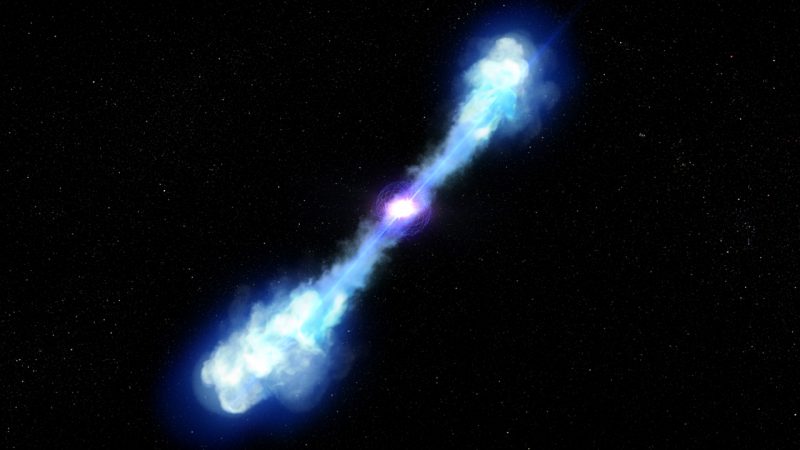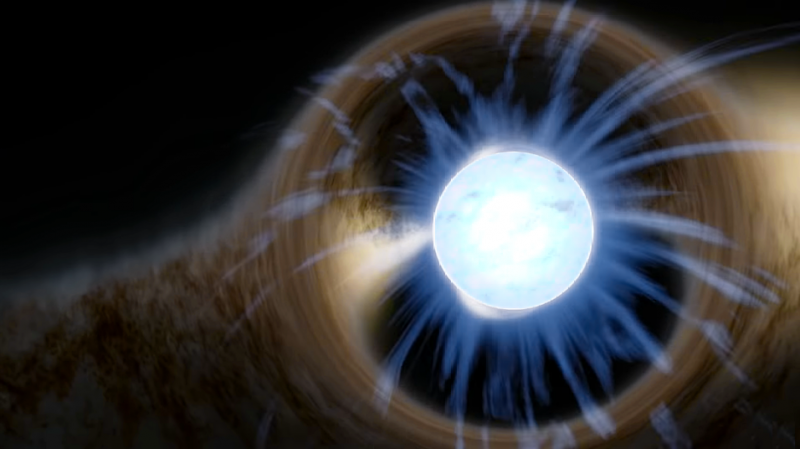
A team of scientists said earlier this month (November 12, 2020) that they’ve observed the most luminous kilonova candidate yet discovered. Kilo means a thousand, and a kilonova bears its name for its dramatic peak brightness, which might be 1,000 times greater than an ordinary classical nova (but only a fraction as bright as a supernova). This one was associated with a short gamma ray burst – labeled GRB 200522A – seen on May 22, 2020. Observations by the Hubble Space Telescope, made in the days after the discovery, showed that the radiation from this distant cosmological event didn’t fit the profile scientists had come to expect from typical kilonovae. It shone as much as 10 times brighter most kilonovae in the near-infrared, as viewed from Hubble three days after the first observations.
Gamma rays bursts are believed to be caused when two neutron stars merge in a violent explosion, and the radiation from hot elements created in the explosion creates what is seen from Earth as a kilonova.
EarthSky 2021 lunar calendars now available! They make great gifts. Order now. Going fast!

According to the paper, to be published in The Astrophysical Journal and currently available at arXiv, the infrared light associated with GRB 200522A is:
… significantly more luminous than any kilonova candidate for which comparable observations exist.

Led by Wen-fai Fong of Northwestern University, the team combined observations from Hubble, the Very Large Array, the Las Cumbres Observatory Global Telescope and the W.M. Keck Observatory. However, Fong said:
Hubble really sealed the deal in the sense that it was the only one to detect infrared light. Amazingly, Hubble was able to take an image only three days after the burst. Hubble’s spectacular resolution was also key in quantifying the amount of light coming from the merger.
Edo Berger, professor of astronomy at the Center for Astrophysics | Harvard & Smithsonian, explained:
The Hubble observations were designed to search for infrared emission that results from the creation of heavy elements – like gold, platinum, and uranium – during a neutron star collision. Surprisingly, we found much brighter infrared emission than we ever expected, suggesting that there was additional energy input from a magnetar [a neutron star with a super strong magnetic field] that was the remnant of the merger.

Why do scientists find GRB 200522A different from other potential kilonovae? Fong said:
Given what we know about the radio and X-rays from this blast, it just doesn’t match up. The infrared emission that we’re finding with Hubble is way too bright. In terms of trying to fit the puzzle pieces of this gamma-ray burst together, one puzzle piece is not fitting correctly.
Several possibilities exist. Berger stated:
What is left behind in such a collision? A more massive neutron star? A black hole? The fact that we see this infrared emission, and that it is so bright, shows that short gamma-ray bursts indeed form from neutron star collisions, but surprisingly the aftermath of the collision may not be a black hole, but rather likely a magnetar.
A magnetar is part of the neutron star family: an ultra-dense star with a magnetic field stronger than Earth’s by a trillion times. Magnetars are short-lived (by cosmic standards) – perhaps 10,000 years – and are the probable source of fast radio bursts (FRBs). Follow-up observations in radio a few years down the line will be able to confirm whether it is indeed a magnetar behind this unexpectedly bright observation.
Bottom line: Hubble Space Telescope observations of a possible kilonova explosion associated with a gamma-ray burst revealed unexpectedly high levels of infrared light. Scientists speculate that the radiation comes from a magnetar – a highly magnetized neutron star – formed by the merger of two neutron stars.











